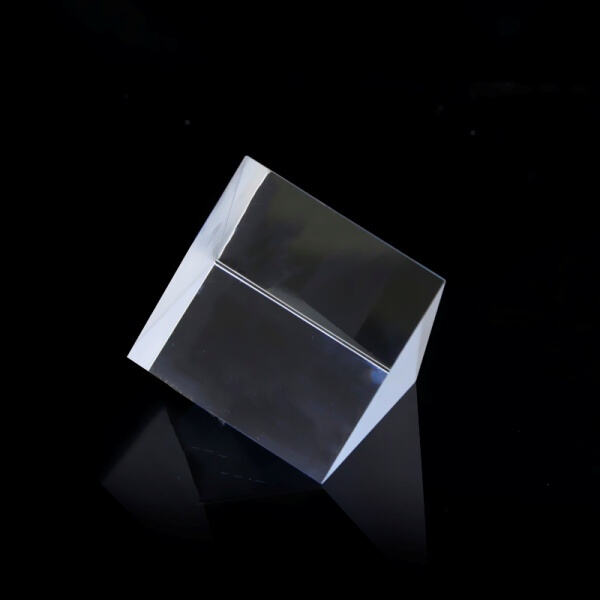
-
+86-156 60188203
[email protected] - Dazhai, Nanyang City, Henan Province China
- Mon - Sat 8.00 - 18.00 Sunday Closed

The Magic of Prisms: A Journey Through Light and Color
Prisms - those magical objects that enrapture us with how they warp light and paint a brand new world of color for our eyes to see, are held in high regard within the optics realm. But no matter if it's glass or another form of clear material, they are all straight-edged and formed geometrically-attracting the attention of scientists an artists alike for centuries. Join us on an adventure in the exploration of prisms and how they shape, propagate & dispense light to show a world of scientific marvel paired with artistic flair.
The magic a prism must accomplish, at its core, is bending light. Since light is moving from one medium to another it changes speed (or slows down) and bends; this phenomenon [of changing direction] is called refraction. So that light ray bending is defined by Snell Law, which determines the angles in refraction and angle at incidence based on two refractive indices of 2 media. The triangular shape of the prism combined with its perfectly flat and smooth surfaces significantly contributes to refracting light beam in a direction such that it travels towards the base side, where another refraction happens on exit, resulting into an stunning spectrum formation from white light.

Prismatic lenses take advantage of the principles provided in prism optics, offering a practically difficult-to-engineer solution based on available optical technology. While standard lenses bend light in one direction or another to bring parallel rays into focus, prismatic optics are designed specifically to shift the path of light without focusing at infinity. This is most useful in addressing certain vision problems like double images (diplopia) or visual field loss. By positioning the prism in an exact degree, optometrists can change where light hits the eye-increasing space sense and 3D vision for that person. In fact, prismatic lenses double for also helping stabilize an image through the lens and reducing eye strain in devices such as telescopes binoculars or cameras.

Through prism optics, the trajectory of human history and culture have inextricably tied to how we see light. Most famously in 1666, Sir Isaac Newton used a prism to show the range of colors present within white light (an icon image returned by Google looking for 'spectrum' is below). This new discovery changed our world of color thinking forever, leading to the development of current psychology regarding light and colours. In contexts which were beyond the scientific world, some of those prismatic effects have served as inspiration to art movements such as Impressionism due their interest on how light and colour interact. Moreover, prisms are an integral part of many industrial sectors such as telecommunications (fibre optics requires them for directing and bending data-carrying light signals).

With prism optics, one can make a better understanding of the basic nature of light like its properties take on wavelength, frequency polarization and so forth. Dispersion, the phenomenon that breaks white light into a spectrum of colours (a rainbow), is caused by the different refractive indices for each colour in material like prism. This serves to remind us of the composite nature of sunlight but also showcases light as having a wave-particle duality -- an aspect which is central to quantum mechanics. Moreover, the study of light's propagation its behaviors inside prisms has led to developments in spectroscopy techniques that now allow scientists to discern basically what it is a particular rainbow glows (or shows) - or does not glow at all- that tells them about where and with what atoms every type of body among heavens are made from.
Nanyang Jingliang is optical component optics of prism area of 10,000 square meters. The company specializes the processing of optical prism lenses, optical system production, sales. We can satisfy all requirements of optical components
The advantages our business is that we offer optics of prism optical prism lens customers' drawings of small to huge size, the number of online production model species more than 400. We have a lot of experience with various items can be customized complete detection equipment
We have a sales and a after-sales team, more 60 employees, our company has a wealth experiences in export and optics of prism cooperation, our optical businesses as well as universities, research centers, research institutions, etc. We have more than 30000 clients over 80 countries all over the globe.
With ISO9001 as well China's high-tech enterprise certificate new technology, CE, SGS certification our company owns more than 300 sets complete equipment, including more than 10 researchers. We ensure the optics of prism quality.
With their incredible history, prisms are still a major innovation driver for a wide variety of industries. In photography and filmmaking, special prisms allow for creative manipulation of the image by splitting the scene into multiple exposures or enhancing color saturation. Endocopic prisms are also used medically for non-invasive exploration of the deep cavities of the body. One field to which the light splitting prisms apply are in environmental monitoring, checking out for pollutants within either the air or water systems so that we can have a healthier surrounding. In fact, in our daily lives as well the inclusion of tiny prisms within smartphones help to improve camera performance and simplify otherwise complex optical systems.
So, the magical universe of prisms is a physical reminder that we are always on edge to solve this optical conundrum. From early experiments to advanced research methods, prisms beam into our understanding of the natural world and long may we continue to be fascinated by intrigue that light discovers with them.
Copyright © Nanyang City Jingliang Optical Technology Co., Ltd. All Rights Reserved — Privacy Policy